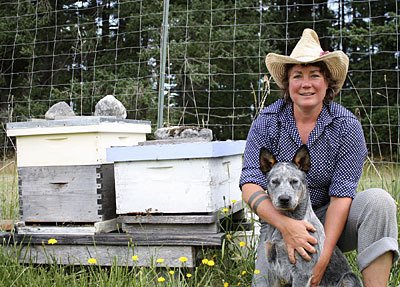With experience as a commercial beekeeper in the Southwest and as a farmer for 12 years, Rhonda Barbieri knows her bees. But she still finds the creatures mysterious and alluring.
“As much as we know about bees, there is that much we don’t know,” Barbieri said during a recent Orcas Rec workshop about beekeeping and honey production.
She taught to a packed class of all ages; the kids in attendance asked a lot of questions: What are the different bee varieties like? How often do you get stung? How long do bees live?
Barbieri calls herself a hobby beekeeper now, and maintains just two hives. She says honey is only an added benefit for her; she keeps bees to pollinate her farm, the La Campesina Project.
Italian bees are what most first-time beekeepers use, as they are gentle. Barbieri calls them the “pussy cat” bees because they almost purr when at work. Buckfast bees, which are what she keeps, are more industrious and produce more honey. She calls them “tiger bees.” The African bee is the most hardworking breed, but also more aggressive and protective of their hive.
According to Barbieri, here on Orcas, bees thrive on blackberry bushes, thistle, and scotch broom. The honey bee is different from the large, furry bumblebee, which lives underground, leads a solitary life for periods of time, and only collects nectar to feed themselves. Like honey bees, they don’t sting unless provoked. Yellow jackets feed off meat, are aggressive, and are prone to stinging without cause.
Honey bees collect nectar to make honey for their hive. They are part of the hymenoptera family, which is Latin for joined (hymen) wing (optera).
Within a honey bee hive, there is one queen, countless worker bees (females), and drones (males). The worker bees live for two to six weeks, and the drones die or are pushed out of the hive at the end of each season.
The queen bee mates with the drones, which are always male, and holds their semen inside of her for the duration of her life (two to five years), and she can choose to produce more worker bees or drones.
The drones do not have stingers and they do not collect nectar; their sole purpose is to mate with the queen bee, which they do while flying. Barbieri says it’s a “beautiful thing to see.” Drones are bigger than worker bees and have larger eyes.
Worker bees have six different jobs: nurses to the young, attendants to the queen, housekeepers, guards, and field workers, who travel between two and eight miles to gather nectar.
Barbieri showed the class one of her bee boxes, which has three levels. The bottom compartment is called the “deep hive body,” which has the largest slots for honeycomb. Once the bees are established and have a healthy population, the “medium hive body” is set on top of the bottom box. The hive’s brood chambers (where the queen, worker bees, and drones live) are in these two boxes. Once they are going strong, a third box is set on top. This is the “super” and it is where the honey is harvested.
Honey bees sometimes need a jump start to get the hive going, so Barbieri feeds them sugar water in a special feeder attached to the deep hive box.
Barbieri says there is a “huge learning curve” as a beekeeper.
“You will make mistakes for the first few seasons,” she said.
She always makes sure to suit up when she tends to her bees, as they are drawn to warmth and pheromones. The most common place for her to get stung is in the armpit.
Barbieri says that the recent decline of bees across the world is due in part to the over-management of commercial bee hives; larger producers often use chemicals to ward off disease, and don’t always treat the bees with care.
“If you can get honey as close to home as possible, and as organic and sustainably produced as possible, the better,” Barbieri said. “Some of the major manufacturers, whose bottles say ‘Grade A,’ put water, corn syrup, and honey from other countries in their product. Countries like South America and China don’t have the same regulations we do, and they use chemicals in their honey.”



